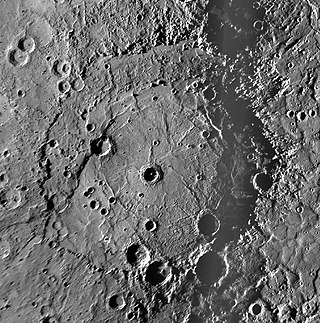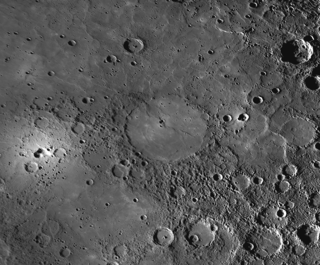
The Ranger program was a series of uncrewed space missions by the United States in the 1960s whose objective was to obtain the first close-up images of the surface of the Moon. The Ranger spacecraft were designed to take images of the lunar surface, transmitting those images to Earth until the spacecraft were destroyed upon impact. A series of mishaps, however, led to the failure of the first six flights. At one point, the program was called "shoot and hope". Congress launched an investigation into "problems of management" at NASA Headquarters and Jet Propulsion Laboratory. After two reorganizations of the agencies, Ranger 7 successfully returned images in July 1964, followed by two more successful missions.

Mary William Ethelbert Appleton Burke, better known as Billie Burke, was an American actress who was famous on Broadway and radio, and in silent and sound films. She is best known to modern audiences as Glinda the Good Witch of the North in the Metro-Goldwyn-Mayer movie musical The Wizard of Oz (1939).

Degas is a rayed crater on Mercury at latitude 37.5 N, longitude 127 W. Its diameter is 54 kilometres (34 mi). It was named after the French impressionist painter Edgar Degas in 1979. The rays consist of light colored material blasted out during the crater's formation. Craters older than Degas are covered by the ray material, while younger craters are seen superimposed on the rays. Degas forms a crater pair with Brontë to the north. Both lie near the center of Sobkou Planitia.

Victoria is an impact crater on Mars located at 2.05°S, 5.50°W in the Meridiani Planum extraterrestrial plain, lying situated within the Margaritifer Sinus quadrangle (MC-19) region of the planet Mars. This crater was first visited by the Mars Exploration Rover Opportunity. It is roughly 800 metres (2,600 ft) wide, nearly eight times the size of the crater Endurance, visited by Opportunity from sols 951 to 1630. It is informally named after Victoria – one of the five Spanish ships of Ferdinand Magellan and the first ship to circumnavigate the globe – and formally named after Victoria, Seychelles. Along the edges of the crater are many outcrops within recessed alcoves and promontories, named for bays and capes that Magellan discovered.

Burke's Garden is an upland valley and unincorporated community in Tazewell County, Virginia.

Molière is an impact crater on the planet Mercury, 139 kilometers in diameter. It is located south of the crater Rodin, southeast of the crater Abu Nuwas, and northeast of the crater Asvaghosa. The nearly circular rim of the crater is cut off into a flat edge on its southern and southwestern ends, and on its eastern side the rim is indented by a smaller crater. The crater is named for the 17th-century French dramatist and satirist Molière. The name was approved by the International Astronomical Union in 1976.

Tir Planitia is a large plain on the planet Mercury. The name Tir (تیر) is the Persian word for "Mercury", and the name was approved in 1976. It was first observed in detail by Mariner 10. It lies between the large crater Mozart and the ancient Tolstoj basin.

Kuiper is a moderate-size crater with a central peak cluster located at 11.35°S 31.23°W on Mercury. It is 62 kilometers in diameter and was named after Dutch-American astronomer Gerard Kuiper in 1976. It is one of only 2 Mercurian craters which are named not after artists, and one of very few cases when the same name is used for 3 craters. Gerard Kuiper, being a leader of American planetary science, died shortly before the first images of Mercurian surface were made.

Eddie is a crater in the Elysium quadrangle of Mars. It is 89 km in diameter and was named after Lindsay Eddie, a South African astronomer (1845–1913).

Dawes Crater is located in the Sinus Sabaeus quadrangle of Mars, at 9.2 S and 38 E. It is about 191 km (119 mi) in diameter, and was named after William R. Dawes, a British astronomer (1799–1868) who was ahead of his time in believing that Mars only had a thin atmosphere. Dawes presumed that the atmosphere of Mars was thin because surface markings on the planet could easily be seen.

Rembrandt is a large impact crater on Mercury. With a diameter of 716 km it is the second-largest impact basin on the planet, after Caloris, and is one of the larger craters in the Solar System. It was discovered by MESSENGER during its second flyby of Mercury on October 6, 2008. The crater is 3.9 billion years old, and was created during the period of Late Heavy Bombardment. The density and size distribution of impact craters along Rembrandt's rim indicate that it is one of the youngest impact basins on Mercury.

Enwonwu is an impact crater on the planet Mercury. It is named in honor of Ben Enwonwu, the modernist Nigerian sculptor and painter. The crater displays a central peak and a set of bright rays emanating from the crater rim. The rays cross the surrounding surface and neighboring craters, indicating that Enwonwu crater was formed comparatively recently in Mercury's history. The brightness of the rays also suggests relative youth, as over time rays darken and disappear on Mercury's surface.

Copland is an impact crater on Mercury. Its floor is flooded with volcanic smooth plains material, which could be related to the activity that formed the nearby bright vent known as Nathair Facula.

Brontë is a crater on Mercury. It has a diameter of 68 kilometres. Its name was adopted by the International Astronomical Union in 1976. Bronte is named for English writers Charlotte Brontë, who lived from 1816 to 1855, Emily Brontë, who lived from 1818 to 1848, and Anne Brontë, who lived from 1820 to 1849, and English writer and artist Branwell Brontë, who lived from 1817 to 1848.

Equiano is a crater on Mercury. It has a diameter of 102 kilometers. Its name was adopted by the International Astronomical Union in 1976. Equiano is named for the abolitionist writer Olaudah Equiano, who lived from 1750 to 1797.

Mofolo is a crater on Mercury. Its name was adopted by the International Astronomical Union in 1976. Mofolo is named for the Basotho writer Thomas Mofolo, who lived from 1876 or 1877 to 1948.

Neumann is a crater on Mercury. It has a diameter of 120 kilometers. Its name was adopted by the International Astronomical Union (IAU) in 1976. Neumann is named for the German architect Johann Balthasar Neumann, who lived from 1687 to 1753.

Baltisk is a crater in the Argyre quadrangle of Mars. It was named after a town in Russia in 1976. Baltisk is located on the western edge of the Argyre impact basin.

The Chryse Alien is a crater in the Chryse Planitia on Mars, named because of its resemblance to an "alien head".





















